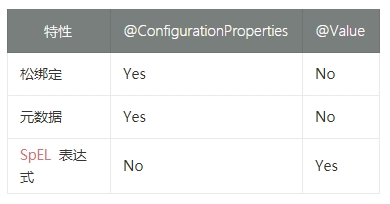SpringBoot 正式环境必不可少的外部化配置

前言
《【源码解析】凭什么?spring boot 一个 jar 就能开发 web 项目》 中有读者反应:
部署后运维很不方便,比较修改一个 IP 配置,需要重新打包。
这一点我是深有体会,17 年自学,并很大胆的直接在生产环境用的时候,我都是让产品经理(此时他充当我们的运维,嘿嘿)用压缩软件打开 jar,然后复制出配置,修改完之后再替换回去。为什么我这么大胆,因为当时才入行一年,而且觉得有架构师兜底,我就奔放了。你是不知道,当时负责这个项目的开发(c#开发)一开始不想用 SpringBoot 的。
不过如今看到这个问题,我有点震惊,都 9102 年了,竟然还担心这样的问题。我想说,哥们,这真的不是事儿。SpringBoot 早就提供了方法来解决这个问题。
SpringBoot 生产特性
SpringBoot 有很多生产特性,可以在生产环境中使用时更加方便。其中外部化配置基本都会用到。
Spring Boot 允许外部化配置,以便相同的应用在不同的环境中工作。
属性值可以在 Spring 环境中使用 @Value 或 @ConfigurationProperties 使用。
此次参考的版本是 SpringBoot-2.2.0.RELEASE
优先级
外部化配置的优先级顺序如下:
- Devtools 全局配置:当 devtools 启用时,
$HOME/.config/spring-boot - 测试类中的
@TestPropertySource - 测试中的
properties属性:在 @SpringBootTest 和 用来测试特定片段的测试注解 - 命令行参数
SPRING_APPLICATION_JSON中的属性:内嵌在环境变量或系统属性中的 JSONServletConfig初始化参数ServletContext初始化参数java:comp/env中的 JNDI 属性- Java 系统属性:
System.getProperties() - 操作系统环境变量
- 随机值(
RandomValuePropertySource):random.*属性 - jar 包外的指定 profile 配置文件:
application-{profile}.properties - jar 包内的指定 profile 配置文件:
application-{profile}.properties - jar 包外的默认配置文件:
application.properties - jar 包内的默认配置文件:
application.properties - 代码内的
@PropertySource注解:用于@Configuration类上 - 默认属性:通过设置
SpringApplication.setDefaultProperties指定
注意:以上用 properties 文件的地方也可用 yml文件
配置随机值
my.uuid=${random.uuid}
命令行属性
java -jar -Ddemo=vm demo.jar --demo=arg
- -Dxxx 为 vm 参数,在代码中通过
System#getProperty获取 - --xxx 为 spring 命令行参数,通过
Environment#getProperty获取,若通过此方法获取不到,会获取 vm 同名参数 - xxx.jar 之后的参数都是 arg 参数,都会在 main 方法中的 arg 数组中获取到
示例
public static void main(String[] args) {
ConfigurableApplicationContext context = SpringApplication.run(ArgApplication.class, args);
LOGGER.info("----------------");
/* 打印 arg 参数 */
Arrays.stream(args)
.forEach(
arg -> {
LOGGER.info("arg:{}", arg);
});
/* 命令行传参 demo */
LOGGER.info("System#getProperty:{}", System.getProperty("demo"));
LOGGER.info("Environment#getProperty:{}", context.getEnvironment().getProperty("demo"));
}
输入命令
java -jar -Ddemo=vm arg-0.0.1-SNAPSHOT.jar aaa bbb ccc --demo=arg
效果如下:
----------------
arg:aaa
arg:bbb
arg:ccc
arg:--demo=arg
System#getProperty:vm
Environment#getProperty:arg
而如果执行命令是:
java -jar -Ddemo=vm arg-0.0.1-SNAPSHOT.jar aaa bbb ccc
结果如下:
arg:aaa
arg:bbb
arg:ccc
System#getProperty:vm
Environment#getProperty:vm
如果执行命令是:
java -jar arg-0.0.1-SNAPSHOT.jar aaa bbb ccc --demo=arg
结果如下:
arg:aaa
arg:bbb
arg:ccc
arg:--demo=arg
System#getProperty:null
Environment#getProperty:arg
属性文件
优先级:
- file:./config/
- file:./
- classpath:/config/
- classpath:/
如果定义了 spring.config.location,如:classpath:/custom-config/,file:./customr-config/,优先级如下:
- file:./custom-config/
- classpath:custom-config/
如果指定了 spring.config.additional-location,会先加载 additional 配置 如:spring.config.additional-location=classpath:/custom-config/,file:./customr-config/,优先级如下:
- file:./custom-config/
- classpath:/custom-config/
- file:./config/
- file:./
- classpath:/config/
- classpath:/
指定 profile 的属性
默认的 profile 是 default,当没有指定spring.profiles.active 属性时,默认会加载application-default.properties 文件。指定 profiles 文件的加载顺序与上述不指定 profiles 文件的加载一致。指定 profile 文件的属性始终覆盖未指定文件的属性。如:spring.profiles.active=dev,则 application-dev.properties文件内的属性会覆盖 application.properties 内的同名属性。
注意:如果在
spring.config.location属性中指定了文件,则此文件对应的特定 profiles 类文件不起作用。如果想要起作用,在spring.config.location中使用文件夹。
占位符
配置文件中可以引用之前定义的值,如下:
app.name=MyApp
app.description=${app.name} is a Spring Boot application.
可以用此特性创建一些已存在的 Spring Boot 配置的较短、易于使用的变量。如下:
# nacos 配置示例
spring:
cloud:
nacos:
config:
server-addr: 127.0.0.1:8848
namespace: d9a39d78-xxxxxxxx-ea4f282e9d99
discovery:
server-addr: 127.0.0.1:8848
namespace: d9a39d78-xxxxxxxx-ea4f282e9d99
# Discovery 配置示例
nacos:
plugin:
namespace: d9a39d78-xxxxxxxx-ea4f282e9d99
可改为如下配置
spring:
cloud:
nacos:
config:
server-addr: ${app.server-addr}
namespace: ${app.namespace}
discovery:
server-addr: ${app.server-addr}
namespace: ${app.namespace}
# Discovery 配置示例
nacos:
plugin:
namespace: ${app.namespace}
app:
server-addr: 127.0.0.1:8848
namespace: d9a39d78-xxxxxxxx-ea4f282e9d99
然后在命令行可以直接通过 -Dapp.namespace 或 --app.namespace 来传参,会方便很多。特别是在多个地方用到同一个属性的时候。
属性加密
Spring Boot 不支持属性加密,但提供钩子节点修改配置属性。EnvironmentPostProcessor 接口允许在应用启动前操作 Environment 。
yaml
yaml 文件使用的时候非常直观、方便。而且在 Spring Boot 中做了处理,获取 yaml 和 properties 文件中的属性基本是一样的操作。
一个文件指定多 pfofile
通过 spring.profiles 指示何时使用对应的配置,使用 ---进行配置分隔
# application.yml
server:
address: 192.168.1.100
---
spring:
profiles: development
server:
address: 127.0.0.1
---
spring:
profiles: production & eu-central
server:
address: 192.168.1.120
yaml 缺点
用 @PropertySource 不能加载 yaml 文件,这种情况下只能使用 properties 文件。
在特定 profile 的 yaml 文件中使用多 profile 配置,会有意料之外的情况:
# application-dev.yml
server:
port: 8000
---
spring:
profiles: "!test"
security:
user:
password: "secret"
当运行时指定 --spring.profiles.active=dev ,启用 dev profile,其它的 profile 会忽略。也就是此例中 spring.security.user.password 属性会失效。
因此,不要在指定 profile 的 yaml 文件中使用多种 profile 配置。
类型安全的属性配置
JavaBean 属性绑定
通过 @ConfigurationProperties 注解将属性(properties、yml 文件、环境变量等)绑定到类对象中。与自动配置类类似。
@ConfigurationProperties("acme")
public class AcmeProperties{
private boolean enabled;
private InetAddress remoteAddress;
private final Security security = new Security();
// getter and setter
public static class Security{
private String username;
private String password;
private List<String> roles = new ArrayList<>(Collections.singleton("USER"));
// getter and setter
}
}
这种安排依赖于默认的无参构造器,getter 和 setter 通常是必需的,因为绑定就像 Spring MVC 一样是通过标准的 Java Beans 属性描述符进行的。在下列情况下,可省略 setter:
- Maps:只要被初始化后,getter 必须而 setter 不必须,binder 可以对它们进行修改
- Collections 和 数组:可以通过索引或逗号分隔的值来设定属性。后者必须有 setter 方法。建议对于这种情况一直加上 setter。如果初始化了一个 Collection,确保它不是不可变类型。
- 如果初始化了嵌套的 POJO 属性(如上例中的 Security),setter 不是必须的。如果需要 binder 通过其默认构造器动态创建实例,则需要 setter
注意:如果使用 Lombok 生成 getter 和 setter,确保不会生成任何特定的构造器,不然容器会自动使用它来实例化对象。
最后,只有标准 Java Bean 属性可以这样绑定属性,静态属性不支持。
构造器绑定
上述示例可以改成如下:
@ConstructorBinding
@ConfigurationProperties("acme")
public class AcmeProperties{
private final boolean enabled;
private final InetAddress remoteAddress;
private final Security security;
public AcmeProperties(boolean enabled, InetAddress remoteAddress, Security security){
this.enabled = enabled;
this.remoteAddress = remoteAddress;
this.security = security;
}
// getter and setter
public static class Security{
private final String username;
private final String password;
private final List<String> roles;
public Security(String username, String password, @DefaultValue("USER") List<String> roles){
this.username = username;
this.password = password;
this.roles = roles;
}
// getter and setter
}
}
@ConstructorBinding 注解表示使用构造函数绑定属性值。这意味着 binder 将期望找到一个包含待绑定参数的构造器。
@ConstructorBinding 类的嵌套成员也将通过构造函数绑定属性值。
可以使用 @DefaultValue 指定默认值,转换服务将字符串值强转为缺少属性的目标类型。
要使用构造绑定,类必须允许使用
@EnableConfigurationProperties或 配置属性扫描方式。不能对由常规 Spring 机制创建的 bean 使用构造函数绑定。如:@Component Bean、通过@Bean 方法创建的 Bean 或使用@Import 加载的 Bean
如果类中有多个构造器,可以直接将
@ConstructorBinding注解使用在要绑定的构造器上。
启用 @ConfigurationProperties 注解类型
Spring Boot 提供了一个基础设施来绑定这些类型并将它们自动注册为 bean。
如果应用程序中使用@SpringBootsApplication,用@ConfigurationProperties注解的类将被自动扫描并注册为 bean。默认情况下,将从声明此注解的类的包中进行扫描。如果要扫描特定的包,可以对 ·@SpringBootsApplication注解的类显式使用@ConfigurationPropertiescan注解,如下例所示:
@SpringBootApplication
@ConfigurationPropertiesScan({ "com.example.app", "org.acme.another" })
public class MyApplication {
}
有时,用
@ConfigurationProperties注释的类可能不适合扫描,例如,如果正在开发自己的自动配置,在这些情况下,可以在任何@Configuration 类上指定要处理的类型列表,如下例所示:
@Configuration(proxyBeanMethods = false) @EnableConfigurationProperties(AcmeProperties.class)
public class MyConfiguration { }
注意:当使用配置属性扫描或通过@EnableConfigurationProperties 注册@ConfigurationProperties bean 时,bean 有一个常规名称:
<prefix>-<fqn>,其中<prefix>是@ConfigurationProperties注解中指定的环境 key 前缀,<fqn>是 bean 的完全限定名。如果注解没有提供任何前缀,则只使用 bean 的完全限定名。
上例中 bean name 是acme-com.example.AcmeProperties。
使用@ConfigurationProperties 注解类型
这种类型的配置在 SpringApplication 外部 YAML 配置中特别适用,如下例所示:
# application.yml
acme:
remote-address: 192.168.1.1
security:
username: admin
roles:
- USER
- ADMIN
@ConfigurationProperties bean 可以像其它 bean 一样注入使用。如下:
@Service
public class MyService{
private final AcmeProperties properties;
@Autowired
public MyService(AcmeProperties properties){
this.properties = properties;
}
// ...
}
使用
@ConfigurationProperties还可以生成元数据文件,IDE 可以使用这些文件提供代码自动完成功能。
第三方配置
除了可以在 类 上使用 @ConfigurationProperties 注解,还可以在 public @Bean 方法上使用它。如果要将属性绑定到不在控制范围内的第三方组件,那么这样做特别有用。
要从 Environment 属性配置 bean,将 @ConfigurationProperties 添加到其 bean 注册中,如下例所示:
@ConfigurationProperties(prefix = "another")
@Bean
public AnotherComponent anotherComponent() {
//...
}
用
another前缀定义的任何 JavaBean 属性都映射到AnotherComponentbean 上,映射方式类似于前面的 AcmeProperties 示例。
松绑定
Spring Boot 使用一些宽松的规则将
Environment属性绑定到@ConfigurationPropertiesbean,因此环境属性名和 bean 属性名之间不需要完全匹配。常见的包括短划线分隔的环境属性(例如,context-path绑定到contextPath)和大写的环境属性(例如,PORT绑定到port)。
@ConfigurationProperties(prefix="acme.my-project.person")
public class OwnerProperties {
private String firstName;
public String getFirstName() {
return this.firstName;
}
public void setFirstName(String firstName) {
this.firstName = firstName;
}
}
对于以上 Java Bean,可以使用以下属性

注意:注解的前缀值必须是短横线 (小写,用-分隔,如:acme.my-project.person)。
放宽每个属性源的绑定规则

建议:如果可能的话,将属性存储为小写的短横线格式,例如:my.property-name=acme。
在绑定到 Map 属性时,如果 key 包含除小写字母-数字字符或 - 之外的任何内容,则需要使用括号符号,以便保留原始值。如果 key 没有被[]包围,则删除任何不是字母数字或 -的字符。
acme:
map:
"[/key1]": value1
"[/key2]": value2
/key3: value3
上面的属性将绑定到 Map 的这些 key 中:/key1、/key2、key3
合并复杂类型
List
当在多个位置配置 list 时,通过替换(而非添加)整个 list 来覆盖。
@ConfigurationProperties("acme")
public class AcmeProperties {
private final List<MyPojo> list = new ArrayList<>();
public List<MyPojo> getList() { return this.list;
}
}
acme:
list:
- name: my name
description: my description
---
spring:
profiles: dev
acme:
list:
- name: my another name
当启用 dev 配置时,AcmeProperties.list 中值包含一个 MyPojo 对象(name 为my another name),不是添加操作,而是覆盖操作。
当一个
List在多个 profiles 中定义时,最高优先级的被使用。
Map
对于 Map 属性,可以使用从多个属性源获取属性值进行绑定。但是,对于多个源中的同一属性,将使用优先级最高的属性。
@ConfigurationProperties("acme")
public class AcmeProperties {
private final Map<String, MyPojo> map = new HashMap<>();
public Map<String, MyPojo> getMap() {
return this.map;
}
}
acme:
map:
key1:
name: my name 1
description: my description 1
---
spring:
profiles: dev
acme:
map:
key1:
name: dev name 1
key2:
name: dev name 2
description: dev description 2
当 dev 配置启用时,AcmeProperties.map 中包含两个键值对。key1 中 pojo name 为 dev name 1,description 为 my description 1;key2 中 pojo name 为 dev name 2,description 为 dev description 2。
不同属性源的配置进行了合并
以上合并规则适用于所有的属性源
属性转换
Spring Boot 试图在绑定到
@ConfigurationPropertiesbean 时将外部应用程序属性强转为正确的类型。如果需要自定义类型转换,可以提供ConversionServicebean(带有名为ConversionService的 bean)或自定义属性编辑器(通过CustomEditorConfigurerbean)或自定义Converters(使用 bean 定义注解@ConfigurationPropertiesBinding)。
注意:由于此 bean 在应用程序生命周期的早期被请求,请确保限制
ConversionService正在使用的依赖项。通常,需要的任何依赖项在创建时都可能未完全初始化。如果自定义的ConversionService不需要配置 keys 强转,并且仅依赖于使用@ConfigurationPropertiesBinding限定的自定义转换器,则可能需要将它重命名。
时间区间转换
SpringBoot 对表示持续时间有专门的支持。如果暴露 java.time.Duration 属性,则可以用以下格式:
- 常规的
long表示(除非指定了@DurationUnit,否则使用毫秒作为默认单位) java.time.Duration使用的标准 ISO-8601 格式- 一种更可读的格式,其中值和单位是耦合的(例如,10s 表示 10 秒)
@ConfigurationProperties("app.system")
public class AppSystemProperties {
@DurationUnit(ChronoUnit.SECONDS)
private Duration sessionTimeout = Duration.ofSeconds(30);
private Duration readTimeout = Duration.ofMillis(1000);
public Duration getSessionTimeout() {
return this.sessionTimeout;
}
public void setSessionTimeout(Duration sessionTimeout) {
this.sessionTimeout = sessionTimeout;
}
public Duration getReadTimeout() {
return this.readTimeout;
}
public void setReadTimeout(Duration readTimeout) {
this.readTimeout = readTimeout;
}
}
要指定 30 秒的 sessionTimeout,30、PT30S 和 30s 都是等效的。500ms 的 readTimeout 可以用以下任何形式指定:500、PT0.5S 和 500ms。
也可以使用以下任何支持的单位:
ns:纳秒us:微妙ms:毫秒s:秒m:分h:时d:天
默认的单位是毫秒,可以使用
@DurationUnit指定
数据 size 转换
Spring 框架有一个 DataSize 类型,以字节表示大小。如果暴露一个 DataSize 属性,则可以用以下格式:
- 常规的
long表示(除非指定了@DataSizeUnit,否则使用字节作为默认单位) java.time.Duration使用的标准 ISO-8601 格式- 一种更可读的格式,其中值和单位是耦合的(例如,
10MB表示 10 兆字节)。
@ConfigurationProperties("app.io")
public class AppIoProperties {
@DataSizeUnit(DataUnit.MEGABYTES)
private DataSize bufferSize = DataSize.ofMegabytes(2);
private DataSize sizeThreshold = DataSize.ofBytes(512);
public DataSize getBufferSize() {
return this.bufferSize;
}
public void setBufferSize(DataSize bufferSize) {
this.bufferSize = bufferSize;
}
public DataSize getSizeThreshold() {
return this.sizeThreshold;
}
public void setSizeThreshold(DataSize sizeThreshold) {
this.sizeThreshold = sizeThreshold;
}
}
要指定 10 兆字节的 bufferSize,10 和 10MB 是等效的。256 字节的 sizeThreshold 可以指定为 256 或 256B 。
也可以使用以下任何支持的单位:
B:字节
KB:千字节
MB:兆字节
GB:千兆字节
TB:兆兆字节
默认的单位是字节,可以使用
@DataSizeUnit指定
@ConfigurationProperties 校验
每当对 @ConfigurationProperties 类使用 Spring 的@Validated 注解时,Spring Boot 就会验证它们。可以直接在配置类上使用 JSR-303 javax.validation 约束注解。必须确保类路径上有一个兼容的 JSR-303 实现(如:hibernate-validator),然后将约束注解添加到字段中。
@ConfigurationProperties(prefix="acme")
@Validated
public class AcmeProperties {
@NotNull
private InetAddress remoteAddress;
// ... getters and setters
}
注意:还可以通过注解@Bean 方法来触发验证,该方法使用@Validated 创建配置属性。
尽管嵌套属性在绑定时也将被验证,但最好对关联字段使用
@Valid。这确保即使找不到嵌套属性,也会触发验证。
@ConfigurationProperties(prefix="acme")
@Validated
public class AcmeProperties {
@NotNull
private InetAddress remoteAddress;
@Valid
private final Security security = new Security();
// ... getters and setters
public static class Security {
@NotEmpty
public String username;
// ... getters and setters
}
}
还可以通过创建
ConfigurationPropertiesValidatorbean 来添加自定义 SpringValidator。@Bean方法应该声明为static。配置属性验证器是在应用程序生命周期的早期创建的,将@Bean 方法声明为 static 可以创建 Bean,而无需实例化@configuration 类。这样做可以避免任何可能由早期实例化引起的问题。
注意:
spring-boot-actuator模块包含一个端点,该端点暴露所有@ConfigurationPropertiesbean。访问/actuator/configprops可获得相关信息。
@ConfigurationProperties vs. @Value
@Value 注解是一个核心容器特性,它不提供与 @ConfigurationProperties 相同的特性。

如果需要为组件定义了一组配置键,建议将它们配置到一个
@ConfigurationProperties注解的 POJO 中。由于@Value不支持松绑定,如果需要使用环境变量提供值,则它不是一个好的选项。
虽然可以在@Value中编写SpEL表达式,但此类表达式不会从 properties 文件中处理。
使用配置中心
如果项目比较大的话,分成了好几个 SpringBoot 工程,可以使用某些 SpringCloud 组件,比如:配置中心。配置中心支持一个地方管理所有的配置,有些还可以支持修改配置实时生效而不用重启应用,真的是很棒棒呢。推荐使用 nacos。如果项目比较小,你用 git 或者指定文件夹来作为配置存放的地方也可以。
怎么样?有了这些用法的支持,你还会觉得 Springboot 打成一个 jar 会在部署的时候很不方便吗?
参考资料
官方文档
公众号:逸飞兮(专注于 Java 领域知识的深入学习,从源码到原理,系统有序的学习)






 浙公网安备 33010602011771号
浙公网安备 33010602011771号